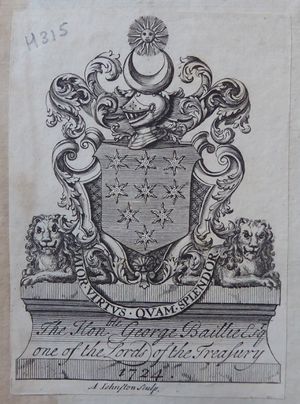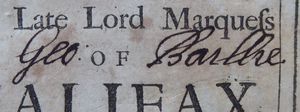Difference between revisions of "George Baillie 1664-1738"
(Created page with "__NOTITLE__ ===name::George name::BAILLIE date of birth::1664-date of death::1738=== ====Biographical Note==== Born at place of birth::Jerviswood Tower, Lan...") |
|||
| Line 1: | Line 1: | ||
__NOTITLE__ | __NOTITLE__ | ||
===[[name::George]] [[name::BAILLIE]] [[date of birth::1664]]-[[date of death::1738]]=== | ===[[name::George]] [[name::BAILLIE]] [[date of birth::1664]]-[[date of death::1738]]=== | ||
| − | + | [[file:P1200657(1).JPG|thumb|The larger of Baillie's bookplates (all images here from a copy of G. Savile, Miscellanies, 1700, private collection)]] | |
====Biographical Note==== | ====Biographical Note==== | ||
Born at [[place of birth::Jerviswood Tower, Lanarkshire]], son of [[family::Robert Baillie]], a Scots landowner who was executed in 1684 for involvement in the Rye House Plot. He then fled Scotland but returned with William of Orange's forces in 1689, when he was restored to his estates and began a career of gradual political rise through a series of positions in Scottish administration. He was [[occupation::MP]] for [[location::Berwickshire]] 1708-34 and became a [[occupation::Lord of the Admiralty]] in 1714, and a member of the [[organisations::Treasury Board]] 1717-25. He was noted for his presbyterian piety and was buried at [[location::Mellerstain]] where he began building in 1725 the grand house which became the family seat through succeeding generations. | Born at [[place of birth::Jerviswood Tower, Lanarkshire]], son of [[family::Robert Baillie]], a Scots landowner who was executed in 1684 for involvement in the Rye House Plot. He then fled Scotland but returned with William of Orange's forces in 1689, when he was restored to his estates and began a career of gradual political rise through a series of positions in Scottish administration. He was [[occupation::MP]] for [[location::Berwickshire]] 1708-34 and became a [[occupation::Lord of the Admiralty]] in 1714, and a member of the [[organisations::Treasury Board]] 1717-25. He was noted for his presbyterian piety and was buried at [[location::Mellerstain]] where he began building in 1725 the grand house which became the family seat through succeeding generations. | ||
| − | + | [[file:P1200658(1).JPG|thumb|Baillie's inscription]] | |
====Books==== | ====Books==== | ||
Baillie assembled a significant library; we do not know the full extent and contents but many books remain today at [[location::Mellerstain House]], and others are widely dispersed around the world. He used two engraved armorial bookplates of different sizes, but very similar design, dated 1724 (Franks 1162-3). | Baillie assembled a significant library; we do not know the full extent and contents but many books remain today at [[location::Mellerstain House]], and others are widely dispersed around the world. He used two engraved armorial bookplates of different sizes, but very similar design, dated 1724 (Franks 1162-3). | ||
| − | + | [[file:P1200656(1).JPG|thumb|One of Baillie's spines, decorated with the heraldic badge tool]] | |
====Characteristic markings==== | ====Characteristic markings==== | ||
As well as the use of the bookplates, Baillie's books were regularly decorated in their spine compartments with a small gilt heraldic badge tool, of a fleece hanging from a bow of ribbon. He also commonly inscribed his titlepages "George Baillie". | As well as the use of the bookplates, Baillie's books were regularly decorated in their spine compartments with a small gilt heraldic badge tool, of a fleece hanging from a bow of ribbon. He also commonly inscribed his titlepages "George Baillie". | ||
Revision as of 02:57, 20 December 2020
George BAILLIE 1664-1738
Biographical Note
Born at Jerviswood Tower, Lanarkshire, son of Robert Baillie, a Scots landowner who was executed in 1684 for involvement in the Rye House Plot. He then fled Scotland but returned with William of Orange's forces in 1689, when he was restored to his estates and began a career of gradual political rise through a series of positions in Scottish administration. He was MP for Berwickshire 1708-34 and became a Lord of the Admiralty in 1714, and a member of the Treasury Board 1717-25. He was noted for his presbyterian piety and was buried at Mellerstain where he began building in 1725 the grand house which became the family seat through succeeding generations.
Books
Baillie assembled a significant library; we do not know the full extent and contents but many books remain today at Mellerstain House, and others are widely dispersed around the world. He used two engraved armorial bookplates of different sizes, but very similar design, dated 1724 (Franks 1162-3).
Characteristic markings
As well as the use of the bookplates, Baillie's books were regularly decorated in their spine compartments with a small gilt heraldic badge tool, of a fleece hanging from a bow of ribbon. He also commonly inscribed his titlepages "George Baillie".
Sources
- British Armorial Bindings.
- Gambier Howe, E. R. J. Franks bequest: catalogue of British and American book plates bequeathed to the ... British Museum. London, 1903.
- Murison, Barbara C. "Baillie, George, of Jerviswood (1664–1738), landowner and politician." Oxford Dictionary of National Biography.


